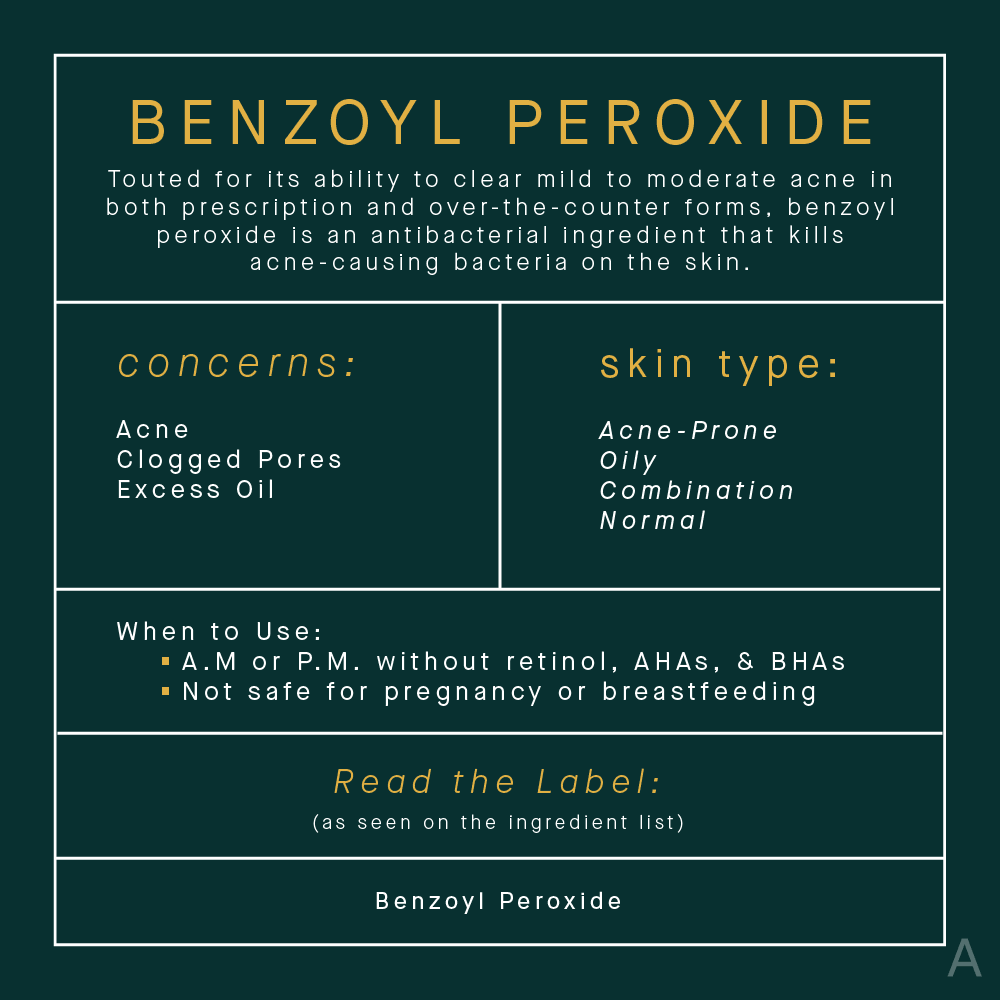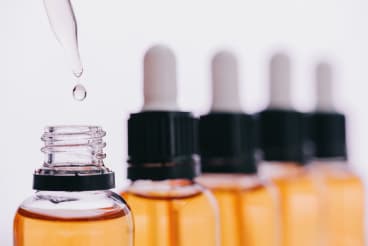 Salicylic Acid Peel
Salicylic Acid PeelRead The Label: All Your Benzoyl Peroxide Questions Answered
You may remember benzoyl peroxide from your teen years, but most people don’t know how or why this antimicrobial works so well. Here’s what the experts have to say about this acne-busting ingredient.
Feel like you need a dictionary every time you look at the ingredient list of a beauty product? Still unsure of the difference between retinol and retinoids? What about the unique benefits of vitamins B, C, and E? Are alpha and beta hydroxy acids the same thing? The skincare aisle can be overwhelming, but you don’t need a PhD in cosmetic chemistry to navigate it. With expert help, The AEDITION is demystifying and simplifying the beauty industry — one label at a time.
Benzoyl peroxide is one of those ingredients that has name recognition. You may not know exactly how it works or what it does, but it remains stamped in your mind from the time(s) when either you or your acne-prone friends reached for it to banish a breakout. But the antimicrobial active isn’t just for teenagers, and, depending on your skin type, it may deserve a spot in your adult skincare routine, too. So, what are the benefits of benzoyl peroxide? The AEDITION asked the experts.
What Is Benzoyl Peroxide?
Benzoyl peroxide is a chemical compound that was first synthesized in 1905. It was initially used to treat burns and varicose leg tumors, but it became recognized for its acne-fighting abilities as early as the 1930s — though it wasn’t an overnight sensation. The ingredient didn’t gain widespread popularity until the 1970s, when formulations containing it were improved. In March 2010, the United States Food and Drug Administration (FDA) issued its final rule to classify benzoyl peroxide (in concentrations of 2.5 to 10 percent) as a permitted active ingredient in over-the-counter topical acne drug products.
Like other peroxides (think: hydrogen), benzoyl peroxide isn’t just antibacterial. It is also a bleaching agent. That explains why you should switch to white washcloths and towels while using a skincare product with the ingredient, and it also explains why some users have reported hair lightening as a result of treatment.
The Benefits of Benzoyl Peroxide in Skincare
Benzoyl peroxide is renowned for its power to clear acne in both prescription and over-the-counter forms. In fact, the latter has a lot to do with why the ingredient became such a fan-favorite. Because it’s both anti-bacterial and anti-inflammatory, benzoyl peroxide works beneath the surface of the skin to:
- Destroy acne-causing bacteria
- Reduce excess sebum (read: oil)
- Treat inflammation
- Decrease the amount of bacteria in follicles and pores over time

So, what kind of acne does benzoyl peroxide work best for? Dendy Engelman, MD, a board certified dermatologist at Shafer Clinic in New York City, says that it’s most useful for mild to moderate cases of inflammatory acne. “Benzoyl peroxide is most effective in treating inflamed acne — pimples and cysts,” she shares. While it could be used to address non-inflammatory comedonal acne (i.e. whiteheads and blackheads), there are likely better solutions. “It is not the most effective treatment for this type of acne,” she adds.
The Best Candidates for Benzoyl Peroxide
Contrary to popular belief, all skin types (not just oily skin) can be prone to acne. Benzoyl peroxide is an effective acne-fighting ingredient, but you should be mindful of your skin type before reaching for the active. Dr. Engelman cautions that benzoyl peroxide is known to cause irritation (including redness, dryness, and peeling), which may make it too aggressive for sensitive skin. If you have dry skin, meanwhile, it may add to the dehydration. Additionally, studies have shown that people with sensitivities or allergic reactions to cinnamon should avoid benzoyl peroxide.
It should be noted that benzoyl peroxide is not safe for women who are pregnant or breastfeeding.
Finding the Right Benzoyl Peroxide Product
More often than not, benzoyl peroxide is found in cleansers and spot treatments, but it's important to make sure the product you choose is something that a) works for your skin type and b) fits in with the rest of your routine.
Those with persistent acne and active breakouts will benefit from a spot treatment, and OTC formulations generally come in percentages of 2.5 percent, 5 percent, and 10 percent. Starting with a 2.5 percent formulation, like the Clear Daily Skin Clearing Treatment from Paula’s Choice, will help your skin adjust to the active. Over time, you may be able to move up to a product like the Clean & Clear Persa-Gel 10 Acne Medication, which has 10 percent benzoyl peroxide.
An all-over cleanser is great for people with mild acne or those with breakouts that have healed but want to keep any recurring ones at bay. Replenix’s Benzoyl Peroxide Acne Wash combines benzoyl peroxide and aloe vera to clear breakouts and promote healing, while the CeraVe Acne Foaming Cream Cleanser contains hyaluronic acid, niacinamide, and ceramides for a moisturizing clean that calms some of the dryness associated with benzoyl peroxide.
You can also visit your dermatologist for a prescription benzoyl peroxide treatment. In some cases, it is paired with clindamycin. Clindamycin slows the growth of acne-causing bacteria, in addition to decreasing swelling. Together, the pair has been shown to act as a topical antibiotic that is effective for patients with mild to moderately severe acne.
And if you’re wondering if you can double up your benzoyl peroxide products, the answer is a little tricky. Everyone’s skin is different, and some people can handle a combo of a benzoyl peroxide cleanser and spot treatment. With that said, it’s always a good idea to take things slow when adding a product or ingredient to your routine — especially when it’s a strong active like benzoyl peroxide. We suggest adding one product at a time and only doubling up if you’re not seeing results.
How to Add Benzoyl Peroxide to Your Routine
Spot treatments are usually used at night, while cleansers can be used morning and night. Benzoyl peroxide may increase your sensitivity to the sun, so it’s important to be extra diligent with your sunscreen routine while using the ingredient.
It should be noted that benzoyl peroxide doesn’t always play well with other actives, including fellow acne-fighters like retinol and salicylic acid. “It's a finicky ingredient that can deactivate a lot of other actives like retinol, retinoids, alpha hydroxy acids, or salicylic acid,” Dr. Engelman explains. “Additionally, it can be over-drying or irritating to sensitive skin, especially when combined with other drying or acne-fighting products.”
If you do have sensitive skin and want to try benzoyl peroxide, start by using a 2.5 percent formulation every other day — and be sure to layer it. Similar to how you might buffer a retinoid, apply a nourishing moisturizer, like the dye- and paraben-free Vanicream Moisturizing Cream or CeraVe’s gentle but powerful Daily Moisturizing Lotion, on top.
Don’t Rush Results
One last note — your experience with benzoyl peroxide may require a bit of patience. While some patients see improvement in a matter of days (some products even promise results in a few hours), it will likely take longer for your acne to fully clear. “Benzoyl peroxide often works within hours, but I recommend that patients allow a few weeks to see if targeted acne treatment products are working,” Dr. Engelman says. “If they do not see improvement within a few weeks, it may be time to try another treatment.”
The Takeaway
Benzoyl peroxide is a strong anti-bacterial and anti-inflammatory ingredient that is used to treat acne and clear pores. It can be used by all acne-prone skin types, but those with sensitive and/or dry skin will want to proceed with caution. Using benzoyl peroxide (in both OTC and prescription form) may require you to stop using retinol and/or other actives for a period of time, so it is important to discuss the ingredient with your dermatologist before introducing it to your skincare routine.
All products featured are independently selected by our editors, however, AEDIT may receive a commission on items purchased through our links.
More Related Articles
Related Procedures

AI Plastic Surgeon™
powered by'Try on' aesthetic procedures and instantly visualize possible results with The AI Plastic Surgeon, our patented 3D aesthetic simulator.

